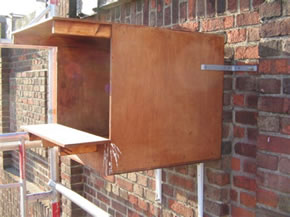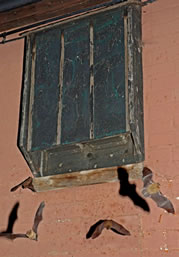

home > complementary features
Introduction
.jpg)
Roosting and nesting habitat is often a key determining factor in whether birds or bats can survive in a particular place. Recent architectural styles have tended to reduce nesting and roosting opportunities for bats and birds. Artificial boxes provide a cost-effective means of providing alternative habitat and helping to conserve wildlife in towns and cities. They also complement the foraging habitat provided by green roofs and walls.
Summary information is provided below on a range of species that can benefit from artificial boxes and structures, along with links to specialist websites that provide more detailed information.
Birds
Birdboxes are available in a range of shapes and sizes, with many designed to benefit particular species.
Swifts (products also relevant to swallows & martins) are one of the bird species most threatened by the regeneration of urban areas. They depend on the voids in roof structures for nesting. Modern building products and techniques tend to prevent access to these void spaces. Swift nest boxes and nest bricks are widely available and can be built into the walls, eaves and soffits of buildings and other structures (e.g. bridges) to mitigate for the loss of accessible void spaces.
More information is available on the London’s Swifts and Concern for Swifts websites.

Peregrine falcons are now nesting regularly in towns and cities and there are examples of the successful use of artificial nesting boxes (attached to the side of buildings) and trays (placed on flat roofs/ ledges) on a variety of buildings across the UK. In keeping with their natural habitat-high cliffs-peregrines like tall buildings. Boxes or trays should therefore be situated as high on buildings as possible. Gravel or an equivalent substrate is then laid inside the tray to provide a nesting scrape for the birds.
More information is available from the Hawk and Owl Trust website.
House sparrows have suffered a catastrophic decline in numbers over recent years. Specially designed house sparrow boxes are available which provide for the nesting of three or more pairs of sparrows.
Other birds – artificial nest boxes are suitable for a wide range of other species including tits, robins, wrens, black redstart, kestrel, owls, wagtails, dippers, jackdaw and starling.
Bats
Bat numbers have declined throughout the UK to the point where six of the seventeen species that exist have been identified as needing special conservation help. Losses of roosting and foraging habitat have been major factors in this decline.
Bats are protected by UK and international law, making it illegal to intentionally or recklessly damage, destroy or obstruct access to any place that a bat uses for shelter or protection, or that is a roosting place.
Buildings are commonly used by bats as roost sites throughout the year. They can squeeze through very small gaps (typically a gap 15-20mm wide is large enough for a pipistrelle bat) and they can therefore take advantage of architectural detail such as weather boarding, hanging tiles, gaps between soffits and walls and holes in ventilation plates and air bricks to access roosting space. Designing these features into buildings will therefore increase roosting opportunities for bats.
small gaps (typically a gap 15-20mm wide is large enough for a pipistrelle bat) and they can therefore take advantage of architectural detail such as weather boarding, hanging tiles, gaps between soffits and walls and holes in ventilation plates and air bricks to access roosting space. Designing these features into buildings will therefore increase roosting opportunities for bats.
Roosting opportunities can also be provided through the use of bat boxes. A wide variety of purpose made boxes are available that can either be attached to the exterior of a building or within a roof void to which bats have access. Bat boxes are used to varying degrees by all species of bat occurring in Britain with the exception of greater and lesser horseshoe bats and grey long-eared bats. Bat boxes are generally occupied by solitary bats, small numbers of males or mating groups. However, nursery colonies of species such as pipistrelles can be encouraged by providing large artificially heated boxes.
Bat bricks and bat roosting units are also available and can be built into walls. Bat bricks either provide slots for bats to roost in, or provide access through walls to voids or roosting units.
More information is available from the Bat Conservation Trust website.
Invertebrates
 Invertebrates pollinate flowers, provide a good source of food for birds and other animals and help to breakdown and process dead and waste organic material.
Invertebrates pollinate flowers, provide a good source of food for birds and other animals and help to breakdown and process dead and waste organic material.
As with birds and bats, the provision of boxes/ structures can support a number of beneficial invertebrate species. Boxes vary greatly between species. Bumblebee boxes are similar in size to small bird boxes, but with two compartments, one in which the queen breeds and one where the other bees live. Boxes for red mason bees and leafcutter bees, both of which are non aggressive and excellent for pollinating plants, comprise a series of tubes.